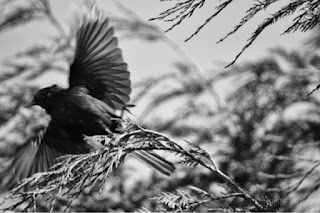13
Feb, 2017
Bird Photography
In my last post, I mentioned photographing wildlife in your back Garden & included Birds within that. However, since Birds are the main type of wildlife that I photograph (though my cats can be pretty wild at times!) & are a great starting subject if Wildlife photography is something you want to pursue further, I thought I'd write a little separate post on Bird photography. Although, I'm definitely not an expert, I thought I'd share a few little tips that help you get started...
So first things first, you need to have Birds visiting your garden!
Tip One: Feed them, if you're not already. This will encourage them into your garden, giving you more opportunities to photograph them. Bird feeders with seeds or fat balls in them seem to go down well for most Birds. Also meal worms & apples cut in half on the ground will encourage ground feeding birds, like Blackbirds to come to your garden.
?
?
Tip Two: Be Patient & Don't Give Up! Getting a good shot can be difficult, especially with small garden birds as they move incredibly fast! This type of photography will give you the chance to play with your shutter speed settings helping you learn how to freeze motion or capture a creative blur to show how speedy these birds can be! So keep at it, your efforts will be rewarded.
?
?
?
 |
| ISO: 220 Aperture: f/5.6 Shutter Speed: 1/500s Focal Length: 300mm |
?
Tip Three: Set Your Camera Up First! (This one can be applied to every time to head out with your camera) It can be so frustrating when you see your shot, sort your camera settings out, go to take a shot, only to see the bird fly off before you've hit the shutter! To help avoid this, before you even think about your first shot, sort your settings out. Adjust your ISO & white balance, you can also set a corresponding Aperture & Shutter Speed but these two will change once you begin to take photographs, especially if you're after a freeze motion type of capture. I usually shoot using Program mode in the garden, which means I can set the ISO & then my camera adjusts the Aperture & Shutter Speed itself. This just means I can concentrate a bit more on the composition & creating the shot I want instead of bothering with settings.
Tip Four: Always Have Your Camera With You. As most amateurs or Pros, we photographers will usually grab our camera as we head out the door just in case we see something that inspires us & we want to capture the moment. Yet, when we decide to simply go & sit in the garden, often the camera is left in the house. I'm speaking from experience & had a number of occasions of running back into the house to get my camera & by the time I've come back, whatever I wanted to capture has gone. So get into the habit of having your camera with you even if your staying around your home & in your garden. You never know when a Bird might arrive in the garden while you're there & without your camera, it'll be a disappointing missed shot because you can guarantee the moment you try to move to get your camera, the Bird will have flown off!
?
?
I think that's all the "wisdom" I can offer when it comes to Bird Photography, I did say I wasn't an expert! I'm sure there's many more of you that know much more about this than me, so feel free to share any tips you may have regarding Bird Photography.
So if you've never tried photographing Birds, why not give it a try.
Happy Snapping!
Louise


